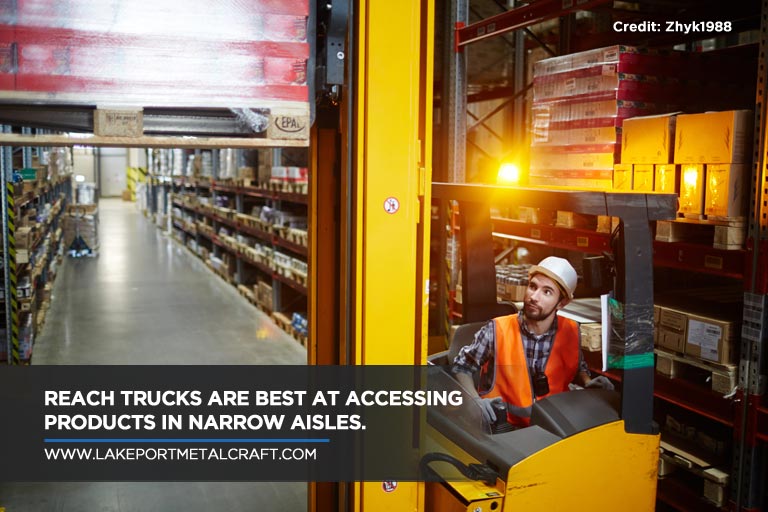Reach trucks are common and useful vehicles in warehouses and storage facilities. If you have space challenges, reach trucks are a great way to increase your storage space without increasing your overall footprint.
If you are thinking about purchasing a reach truck, you may have questions about how they work and how a reach truck can help your operation. Here are some facts and information on the benefits of buying a reach truck machine to help you decide.
What is A Reach Truck?
A reach truck is an electric type of forklift that is designed to pick up and put away inventory. It works well in spaces with narrow aisles that require a small turning radius such as warehouses and storage facilities.
Reach trucks have a single set of wheels in the back that are located below the driver’s seat position and two outer legs that help distribute the load. One unique feature is that the driver sits sideways when operating a reach truck. Because of the design of the legs, reach trucks do not need a counterweight to balance the load.
They are best for storing and retrieving pallets in racks and can often shelve pallets one or two deep. They are also able to reach much higher than traditional forklifts. This means with a reach truck, you can store product higher and access pallets deeper than with a forklift.
Where Are Reach Trucks Used?
Reach trucks are specially designed to work in narrow aisles in warehouses and storage facilities. They allow you to stack products at a greater height and maximize the use of your storage space.
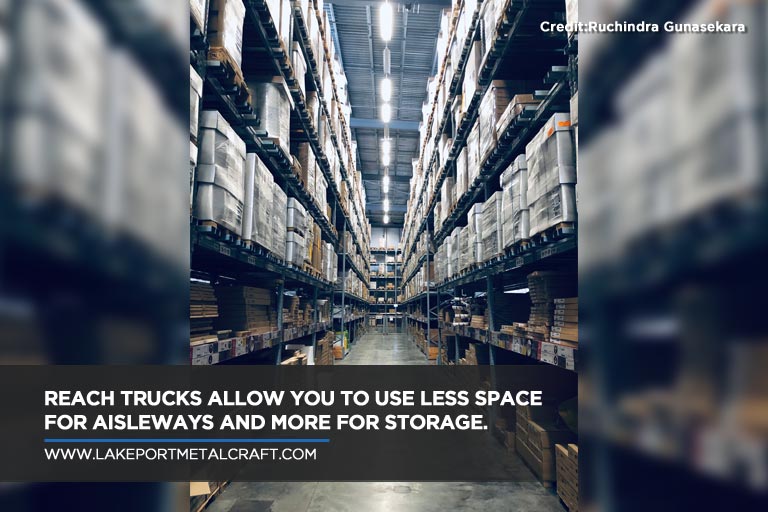
Storage space is always a concern for business owners. With online shopping and consumers wanting immediate access to goods, there is a growing demand for places to store all these products. Warehouses need to maximize their available storage space efficiently to stay competitive and keep up with demand. One way to help manage and maximize storage space is with a reach truck.
Often if you try to stack more into a warehouse, problems arise because products become more difficult to reach. It doesn’t help if you can get to your product when you need it or if you have to move other products in order to access the required item. With a reach truck, you can maximize your space and still easily get to your inventory when you need it. Because of its smaller footprint and smaller turning radius, you will have more space for shelves instead of aisles and can fit more product into the same area.
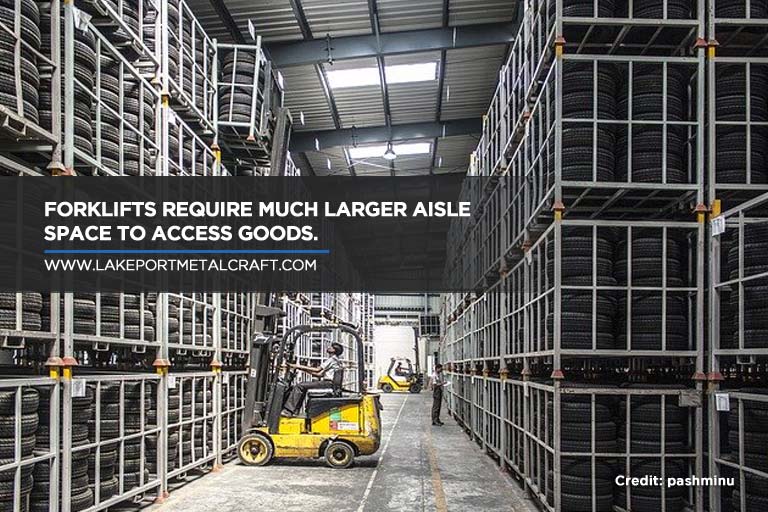
Reach Truck vs Forklift
When you compare a reach truck to a forklift, you are talking about vehicles that can do similar jobs with slight differences. Because reach trucks have stabilizing legs at the front, they do not need the counterbalance weight as a forklift does.
- Wheelbase – The wheelbase of a reach truck is the same length as a regular forklift, the body of a reach truck is far more compact. The design means that operators can reach higher shelves with less of the load sticking out from the truck, allowing it to navigate much tighter spaces.
- Turning radius – To compare, reach trucks require a 2.4m working aisle to manoeuvre, a forklift needs 3.7m to reach the same materials. This is a 35% difference in space, meaning you can reduce your aisles by 35% and use this space for storage.
- Lift capacity – Reach trucks also have the same lift capacity as a forklift, with many models able to lift up to 4500 lbs.
- Height – Most forklift models can safely reach to heights of up to 25 ft. Reach trucks can reach a much higher 36 ft, depending on the model. This means that not only do you need less aisle space, you can also stack products at a greater height.
- Working conditions – Although reach trucks can handle outside working conditions as long as the ground is level and flat, they are usually used indoors. The undercarriage has a low clearance, and this causes difficulty working on uneven surfaces.
While most forklifts are available as electric, propane or diesel, reach trucks are all powered by an electric battery. Reach trucks can also be equipped to load and unload trucks with pallets and work as a traditional forklift.
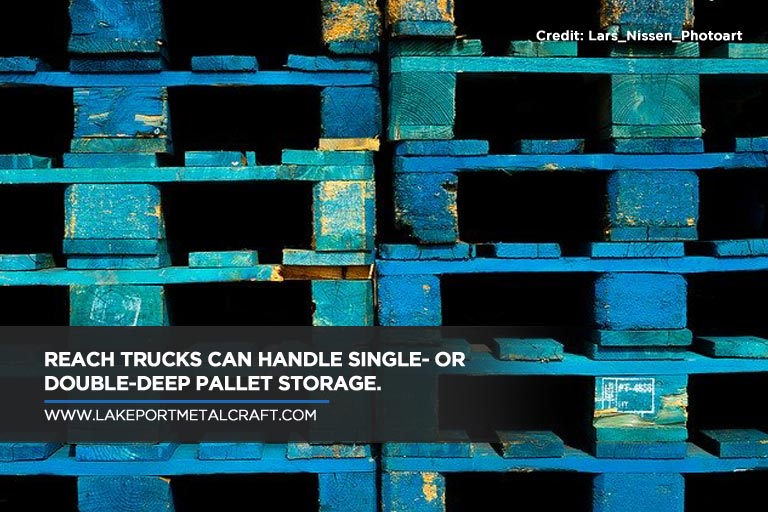
Different Types of Reach Trucks
There are two main types of reach truck, the pantograph reach truck and the moving mast reach truck.
- The pantograph uses a scissor-like design to reach forward and extend the forks to handle pallets in either a single-deep storage structure or double-deep storage. The double deep trucks are usually able to reach right to the bay of the bay. The single deep pantograph is the most common type of reach truck used in North America.
- The moving-mast reach truck uses a hydraulic system on rails that allows the entire mast to move forward. A moving mast reach truck is not able to handle double deep racking without using a fork extension attachment.
Safety Considerations For Reach Truck Operators
Reach trucks are considered safe working vehicles, but like with any industrial machine, specific training is needed to operate them. Reach truck manufacturers recommend specific training for reach truck operators. There are also special considerations that come with reach trucks that are important to understand.
- Specialized training – Simply because a person is trained to operate one kind of reach truck does not mean they have the skills to operate any category of reach truck. Reach trucks come in different truck categories, each requiring training for their specific reach truck.
- Height – Because reach trucks are able to lift much higher than traditional forklifts they carry an increased risk. Operators need to be aware of the risks and have the special skills needed to work safely at height.
- Inclines – Inclines can pose a big risk for reach truck operators. Anyone operating a reach truck must understand how to negotiate an incline safely.
- Stability – Reach trucks have a different centre of gravity than forklifts. Operators need to know how to manage the load capacity and how it relates to the balance of the machine when working at height or maneuvering through a warehouse.
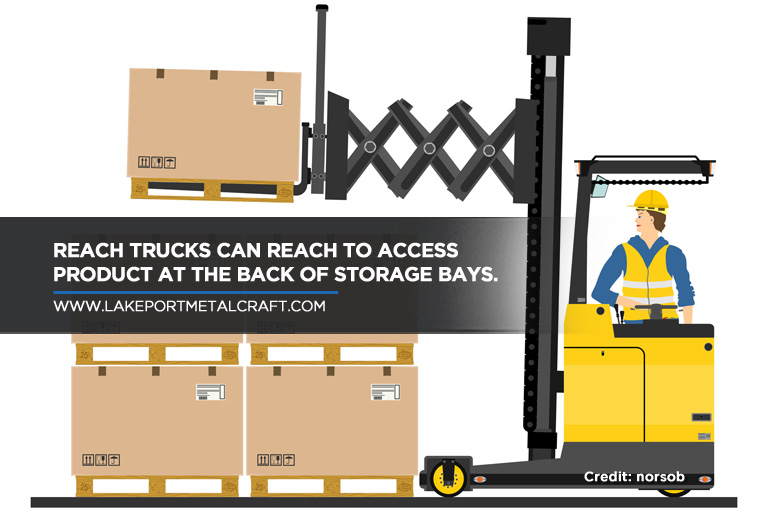
If you are looking to maximize your warehouse space and looking for a vehicle that maneuvers well in small spaces, can work at height and has the capacity to lift heavy loads, a reach truck may be just the piece of equipment you are looking for. We hope these reach truck tips have helped answer some of your questions.
For information on more ways to keep your reach truck operators safe from injury and underride, contact Lakeport Metal Craft Inc.at 416-587-5809 to learn about The Backbone for reach trucks and standup forklifts. The Backbone is an easy-to-install, ANSI-compliant safety bar that acts as a bumper to help keep your operators safe.
Contact us or one of our dealers, Liftow, LiftTruck.com, and SUMOSafe, for more information.

